Chair Mat Buyer's Guide
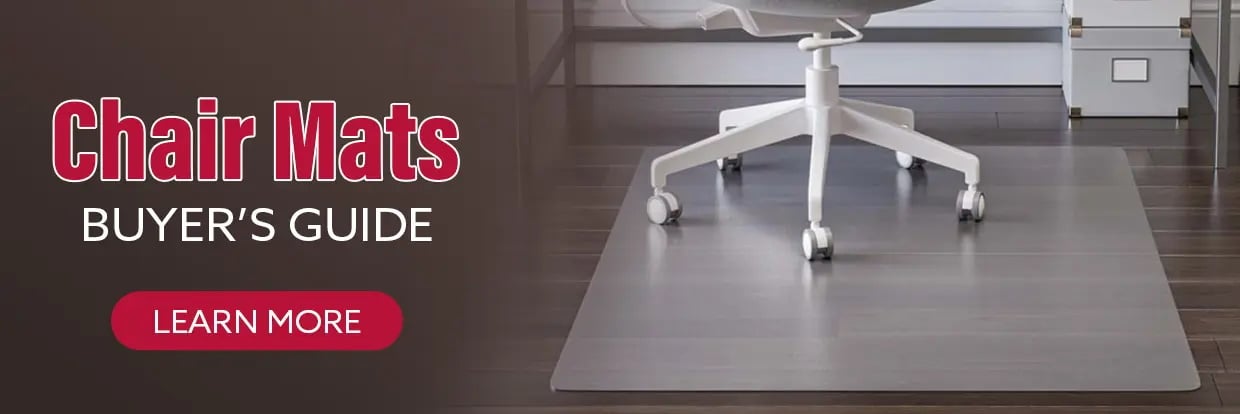
Chair Mat Buyer's Guide: Finding the Perfect Solution
Chair mats may not be something that’s at the top of your shopping list for office supplies or decor. Yet, these commonly overlooked office accessories offer more than just something for your office chair to roll on. It is commonly known that chair mats protect your rugs, carpets, and floors from damage caused by chair casters. But many don’t know that chair mats are also an ergonomic office accessory that reduce the danger of lower body fatigue and repetitive stress injuries.
In this buyer’s guide, we will cover several topics to help you better understand these convenient office add-ons as well as how to choose a chair mat for your needs.
• How to choose the best chair mat• The purposes of chair mats
• Advantages of office chair mats
• Which type of chair mat is best for which type of flooring
• Chair mat materials and when to choose which
• Why the thickness of the mat matters
• How to know if you should get a chair mat with spikes or without
• What a chair mat lip is and whether or not you need it
• An introduction to standing desk mats
• Chair mat frequently asked questions
Benefits of Chair Mats vs. Not Using Them
Even if you think you spend hours at your desk, it's likely that you actually walk around quite a bit. You very likely roll your chair from side to side, in, and out more often than you realize. The movement puts strain on the floor and the chair, and over time, will wear down both prematurely. If your floors are carpeted, in addition to putting stress on your chair, it could also result in back and leg problems. But there is a simple solution: a chair mat. These basic office accessories make a huge difference in how easy it is to roll your chair around while also protecting your flooring and chairs from undue wear and tear. There are many other benefits of a chair mat to consider as well.
Why Office Chair Mats are a Great Buy
• Chair mats protect floors from spills, dents, scuffs, and other damage.
• Chair mats can help with movement and reduce leg fatigue from an ergonomic standpoint.
• Anti static chair mats prevent static shocks from occurring when chairs move because they lower static electricity. They are made to safeguard delicate equipment, making them perfect for computer rooms.
• Chair mats are affordable, especially when you consider the cost of having to repair damage to your floor or carpet.
• Chair mats are environmentally beneficial for safeguarding home and business surfaces. They are manufactured from renewable energy and recycled plastic.
What Happens When you Don’t Use a Chair Mat
• Many flooring manufacturers will void warranties on new installations if you don’t use a chair mat to prevent this damage.
• Rolling back and forth on a carpet with no chair mat can pull carpet fibers up, damaging your carpet.
• Without a chair mat, you can cause unnecessary strain and injuries to your legs and back.
• Without a chair mat on a carpeted floor, you’re more likely to damage your electronics or computer with static electricity.
Chair Mat Selection Guide
Whether the area is carpeted or has a hard floor, there is a chair mat solution available. It's crucial to think about how the characteristics of each chair mat will impact the user experience before making a purchase. Where the chair will be placed is among the most key considerations.
How to Choose a Chair Mat Based on your Flooring
Chair mats aren’t a one-size fits all purchase for your office. In fact, the chair mat that you choose will greatly affect your office space. There are several factors to take into consideration when comparing your options. Things like size, shape, beveled edges, non-beveled edges, material, and floor type will likely play into your choice.
Chair Mats for Carpet Floors
When you’re selecting a chair mat for carpet flooring should consider a few things. For area rugs and carpets, several pile heights (or the fluffiness of the carpet), are available. High-pile carpets are silky and dense, whereas low-pile carpets are robust and thin. Because carpet chair mats include tiny studs on the bottom to grip the carpet's surface, the height of the carpet pile is essential.
Purchasing an anti static chair mat for carpet is a smart move if your workstation includes computers or other electrical gadgets. Your chair mat should be thicker the thicker your carpet is. Placing thinner mats on carpets with thick cushioning may cause them to bend or break.
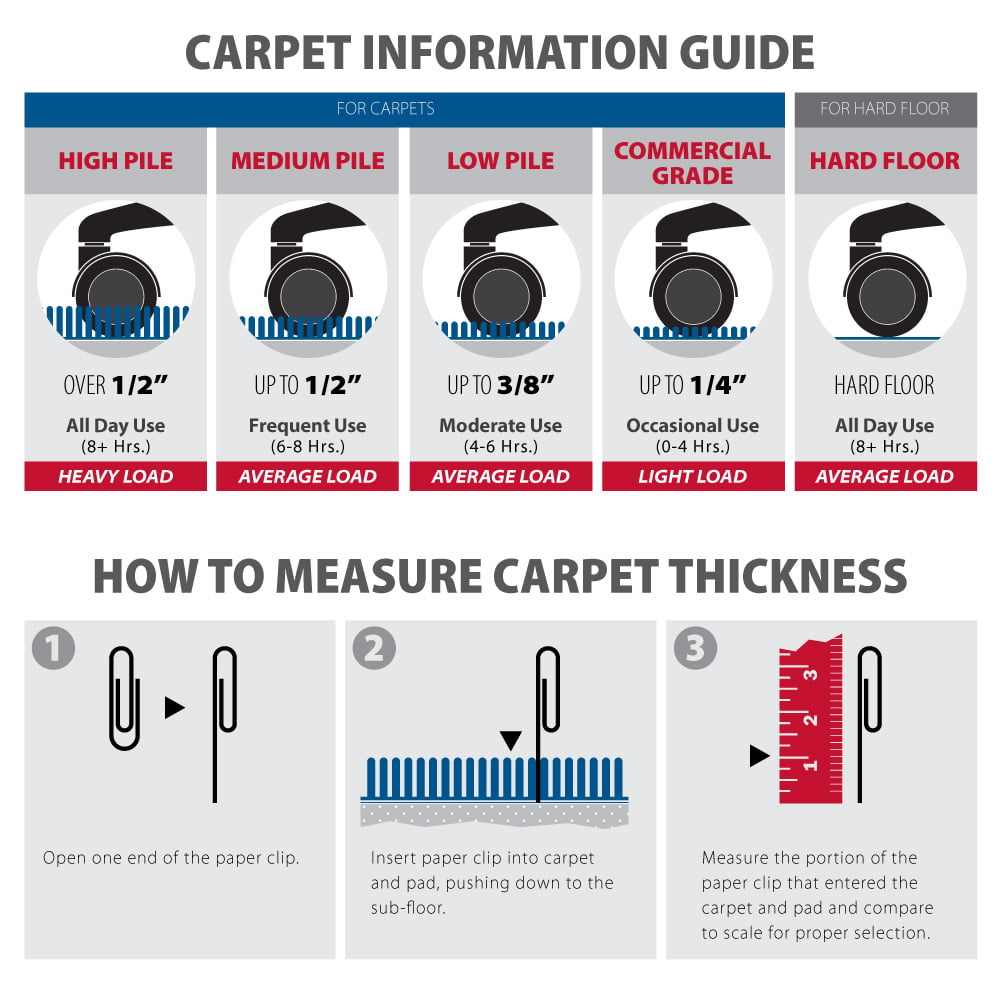

Carpet Thickness
Shorter mats are typically needed for low-pile carpets, whereas taller mats with longer spikes are needed for high-pile carpets. The longer spikes are needed for the high-pile carpet to ensure the office chair mat stays in place. While using a shorter spike in a high-pile carpet may work, a low-pile carpet can’t support the chair mat properly with longer spikes.
• Chair Mats for Low Pile Carpets: Low-pile carpets are the kind that are often found in offices. Because they are short, firm, and rigid, they are easy to clean and don't drag when you walk on them. These require chair mats for carpets that are somewhat level and are similar to hard surface flooring.
• Chair Mats for Medium Pile Carpets: Although they rarely appear in offices, medium-pile carpets are slightly longer and more common in households. Chair mats for carpets having slightly thicker materials and spikes are necessary to keep these in place.
Despite the fact that they are frequently found in homes, high-pile carpets are infrequent or never found in offices due to their deep pile, the difficulty of cleaning them without a considerable investment, and the possibility of wear from continual use. In order to keep them in place, these call for chair mats that are very thick and spiked.
If you're unsure, you can use the paperclip measuring method to help determine your chair mat thickness. Grab a paper clip and flip the first curve out straight, then insert it through the carpet and mat down to the sub-floor. Measure that portion of paperclip that entered the carpet and mat. This is what you will use to determine how thick your chair mat should be.
If your office is equipped with electronic devices like PCs, making the investment in an anti static chair mat is beneficial. A chair mat that is thicker than carpet is recommended. On thick carpeting, chair mats with little matting may distort or crack.
Chair Mats for Hard Floors
If the floor is composed of a hard material, such as tile, hardwood, laminate, or vinyl, use a chair mat for hard floors with a smooth backing to prevent movement and damage to the floor. These mats often have straight, as opposed to beveled (sloped), edges and are thinner.
A chair mat for hard floors should be flat. If the chair mat had spikes, it would be elevated, uneven, and uncomfortable to sit on or walk on.
Hard surfaces like oak hardwood flooring and laminate require this protection. They can be refinished if a chair causes too much damage, but it takes time and money to do so. It should be sealed in place or cleaned frequently to stop grit from getting underneath the chair mat and the slight motions from rolling on it from rubbing against the surface.
Whether or not you need a chair mat will depend on how hard the tile is. If it's generally flat, like the tile found in many government buildings, you may not need a chair mat because the tiles may be sturdy enough to withstand the rolling of a chair without the need for added protection. If the flooring is more like tile with gaps, a chair mat can help avoid the chair from breaking a tile or sliding in the grout.
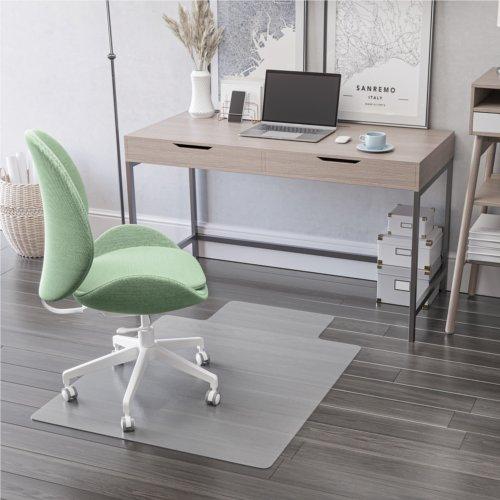

How to Choose a Chair Mat Size & Shape for Your Space
To accommodate your office, office chair mats come in a variety of sizes. However, there is no one-size-fits-all when it comes to what desk chair mat is most functional. The size and shape you choose should be enough to cover where your chair will roll. Some users get bigger sizes for aesthetic purposes or to protect the floor from other office furniture. Measure the area of your workstation that you want the chair mat to cover; this should be where your chair rolls around the most.
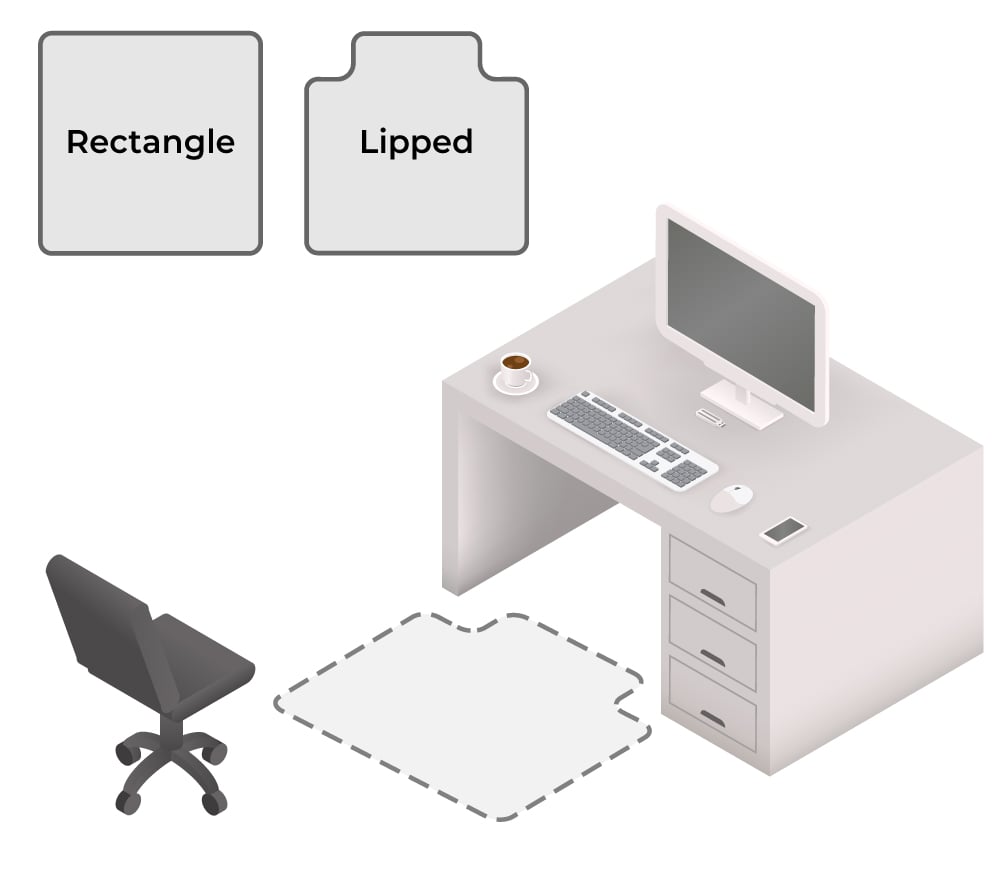

Your office furniture arrangement impacts how your chair mat is shaped. The two most common shapes are a rectangle and a thicker T shape. The T-Shape chair mat has a tab that fits underneath the desk but leaves plenty of room for the chair to sit and roll under it. Other chair mats are available in various shapes and can be cut into a unique shape if you buy a huge desk mat and want to trim it down yourself.
The chair mat's shape is only significant from a functional standpoint; it does not impact how well it performs. Before selecting a shape, consider the size and layout of the available space. Where will your chair be rolling? Any place where a chair might roll about while being used must have a chair mat. You could also get a huge square mat under your desk to cover your workspace and anywhere that your chair will roll.
Choosing a Chair Mat Material: The Pros/Cons of Each
Chair mats typically come in between four and eight different materials. Your aesthetic preferences, the material's texture, and durability all play a role in your decision.
PVC material chair mats are the most widely used and cost-effective. These are the cloud-patterned plastic chair mats that may be found in offices worldwide. They are comfortable, sturdy, and affordable, making them suited for most workplace settings. However, they can weaken and break with time, and are generally difficult to clean.
Another option for desk chair mat material is Polycarbonate chair mats. These are more aesthetically satisfying because they create a seamless appearance with your office floor by using translucent material. However, these are not ideal on high-pile carpets because of how rigid they are; unable to flex on the carpet, they can crack under the pressure. Polycarbonate chair mats are best for hard floors and low-pile carpets.
Tempered glass chair mats are not only beautiful and robust but highly durable; capable of withstanding up to 1000 lbs.! Glass chair mats maintain their translucent appearance over time, and are easy to clean and are resistant to scratching. However, tempered glass chair mats are generally more expensive than others and work better in smaller workspaces.
Choosing a Chair Mat Based on Aesthetics
Desk chair mats come in a lot of different styles, so it's important to choose the one that works best for your environment. Using the factors mentioned in this buyer’s guide, you can choose the best chair mat. With the right chair mat, it's easier to move around, sit, and work at a desk, and the floor stays in better shape. That being said, your chair mat's aesthetic appeal is purely decorative. Choose a color and design that simply complement your workspace without worrying about the mat's look.
The majority of chair mats are either transparent or frosted. The frosted appearance does the best job of hiding minor flaws, dust, and scratches. Chair mats made of tempered glass also come in both clear and frosted varieties. These options are the most popular choice for those looking to have a minimalistic look in their office.
For those who want a more opaque chair mat, there are colored plastic and wooden chair mat options. These offer the choice to customize your space with different wood grains or fun colors.
Why Chair Mat Edges Matter
The chair mat edge type should be the last consideration when purchasing a chair desk mat. The edge may be beveled (sloped) or straight. Having a chair mat with a straight edge for hard floors is crucial. For carpeted environments, a chair mat with a beveled edge is recommended. Chair mats with beveled edges allow a seamless change from the carpeting to the chair mat and work best for regular rolling on or off of your chair mat. With thicker chair mats, beveled edges are nearly always preferable.
Why Standing Desk Mats are a Smart Solution for Standing Desks
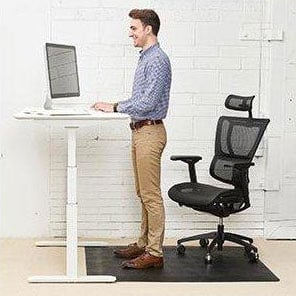

We all know that standing desks are making the workplace healthier and more efficient. But standing for long periods of time without the proper support can strain your feet and knees, especially when wearing heels or other work shoes. And there are also those who stand for long periods of time away from the desk, such as chefs and manufacturing employees. Adding proper support with a standing desk mat can help alleviate some of that strain and make for a safer, more comfortable work environment.
Anti-fatigue mats for standing desks give your feet comfort and support so you can stand for long periods and work more effectively. The outer layers of these cheaply made chair mats are made of vinyl, polyurethane, or rubber with a thin layer of foam or gel in between them. It could harm your posture, cause back pain, and add undue pressure to your feet and joints. But with the proper standing desk mat, you can comfortably work at your standing desk for long periods.
If you’re looking for a durable and firm desk mat, you can look for commercial grade mats. Made with polyurethane material, these standing desk mats are specifically designed to last for years and maintain their buoyancy and firmness for much longer.
Chair Mat FAQs
How should I choose an office chair mat?
The first step in choosing an office chair mat is what type of floor you have. If you have a high-pile carpet, then you should choose a chair mat with long spikes. If you have a low-pile carpet, you should look for chair mats that have shorter spikes. If you have hard floors like hardwood or tile, you can skip the spikes since they will only damage the floor. Instead, look for a chair mat that has a smooth, flat back.
Next, you will need to decide how big you need your chair mat to be. Will the chair mat go just under where I roll my chair? Or do I want to have one big enough for the desk to sit on as well? If you want to cover the area where your chair rolls under the desk, look for a chair mat with a lip to fill in that space.
Lastly, choose the materials and designs that work best for you. Some office chair mats come in clear, frosted, solid colors, or designs. Based on the rest of the factors, this will be the last choice you make in choosing the best chair mat for your workspace.
What is the Best Chair Mat for a Hard or Wood Floor?
The most important consideration when buying a chair mat for a hardwood floor is to choose one that has no spikes on the bottom. You may also consider lips on the edge in case of a rollover. Here are ourA top picks for hardwood floor chair mats.
Will my Rolling Office Chair Damage my Floor?
Yes, chairs with wheels often cause damage to hardwood floors, tile, and carpet. The wear of being rolled on over and over in the same spot naturally wears down the surface. A chair mat is a great way to protect your flooring.
Is there a Best Chair Mat to use on Carpet?
The ideal chair mat to use on a carpeted workspace would be one with spikes underneath to grip the carpet and a smooth top for the chair to roll across. If you have a short-pile carpet, look for chair mats with short spikes, and look for longer spikes if you have a high-pile carpet. Check out our most popular chair mats.
What are the Different Types of Office Chair Mats?
A chair mat that’s 36 inches deep by 48 inches wide will typically be adequate for a typical desk and chair setup. Smaller versions of desks can have smaller chair mats, whereas a table might need something a little bigger.
How much does an Office Chair Mat cost?
If you’re on a budget, you can still find a good, sturdy chair mat for under $100. In this under $100 price range, you will find mats for both hard floors and carpets, sized 36” x 48” for mid-size workspaces, with and without lips, and for light to moderate use. Other office chair mats will increase in price due to size and materials.
What is the best material for an office chair mat?
Polycarbonate plastic is the ideal material for a chair mat on a carpeted area. This material is a thermoplastic that is usually transparent, highly strong, and simple to shape. It doesn't bunch or breaks under a chair's wheels or legs, staying level the entire time.
Chair mats made of polyethylene are typically transparent and can be placed on any hard floor. In addition to being resistant to scratches and chips, many of these surfaces also have a slick, textured surface that facilitates simple chair movement. Additionally, several alternatives include a built-in lip that shields your floor from damage.
What is the best office chair mat brand?
Deflecto. is the chair mat we prefer the most. Their chair mats are designed to protect floors for years without curling or cracking, offer a secure rolling surface, and appropriately grip the floor. To lessen your exposure to potentially harmful compounds for the environment and your health, their entire collection of vinyl chair mats is created from renewable plant-based materials.
How thick should a chair mat be?
The best chair mats are typically between 3 and 5 millimeters thick since this thickness offers enough rigidity and strength to withstand pressure from chair wheels.
Although there are chair mats that are thinner, they might not perform as well in carpeted areas. It is difficult to roll across the surfaces of these mats since they have a tendency to clump or sink underneath a wheel. They will safeguard the carpet but may be difficult to utilize.
Do Chair Mats ruin carpet?
It does if you match the incorrect carpet with the wrong chair mat! The fibers of your carpet may break down and develop damage if you use mats that are heavier or have features that don't match the sort of carpet you have (such as a chair mat with medium-sized cleats for a low pile carpet).
Are Chair Mats Worth it?
In short, yes, chair mats are worth it. Chair mats can protect your hard floors from scratches and scuffs and protect your carpet from damage or spills. Chair mats also can reduce lower back and leg pain by making it easier to slide across the floor.
How Thick of a Chair Mat do I Need?
The chair mat thickness you need will be based on the type of flooring you have. If you have a hard floor, the thickness can be anywhere from 0.4” to 1” thick. For carpeted areas, 1” thickness is normally sufficient to give a notable anti-fatigue effect and floor protection.
Should you use a chair mat on hardwood floors?
Using the right chair mat for hard floors will help preserve the quality and protect it from unwanted scratches and scuffs. Make sure that the chair mat you choose for your hard floors is spike-free!
What can I use instead of a chair mat?
Rollerblade-style wheels can replace office mats on hard surfaces. Rollerblade casters prevent wear and tear on hardwood, vinyl, laminate, and other hard floors. Sit-stand stations and standing work desks can also lessen the requirement for rolling chairs (and hence minimize the effect of rolling over the floor), but you'll probably still need to balance standing time with a rolling chair.
Choosing Your Chair Mat
The benefits of chair mats are vast; quite larger than most people realize at first glance. It’s always a smart choice to protect carpets and hard floors from office chairs' everyday wear and tear with chair mats that slip beneath desks and other equipment. Each mat is constructed with sturdy, flexible materials to withstand light to heavy use, desks, and walking on. These office chair mats may be used on carpet or hard surfaces and are available in various sizes, designs, and colors to suit any desire. Thanks to MyBinding's wide collection of mats, finding the perfect mat for the house or office is straightforward.
Not sure which is the best chair mat for your needs? We have professionals for that. Give us a call at 1-800-944-4573.






